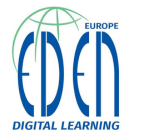At the Editorial board meeting that took place during the EDEN conference in Lisbon, we discussed how multimedia and web 2.0 services could improve EURODL (EDEN’s online journal). A few days earlier, I was given two weeks to produce a video introducing an article I wrote for seminar.net. When I checked the journal’s web site, I was surprised to see that all articles published since 2005 had video introductions.
This made me realize that online journals may benefit from the fact that many successful web 2.0 services have an interesting and useful feature called embedding. Authors may for example easily embed videos from YouTube.com, PowerPoint presentations from Slideshare.net and speech synthesis from ReadTheWords.com. Even cartoons from Toonlet.com can be embedded as I did in my previous blog entry on Transparency in Cooperative Online Education. The embedded resource will appear as an integral part of the article, even though it is just an html code the author includes in the document. Therefore, embedded material may easily liven up articles in online journals and blog entries.
To give one example, some of the above mentioned services are included in the YouTube video embedded in this blog entry. The amateur video introduces my article “Cooperative Online Education“. In the video, I wanted to convey that individual learning is conducted alone, collaborative learning depends on groups and cooperative learning takes place in networks. The concluding statement is that web 2.0 eventually makes it possible to apply the theory of cooperative freedom in online education.Take a look at the video and feel free to embed it in your own web pages. The only thing you need to do is to insert the following html code:




